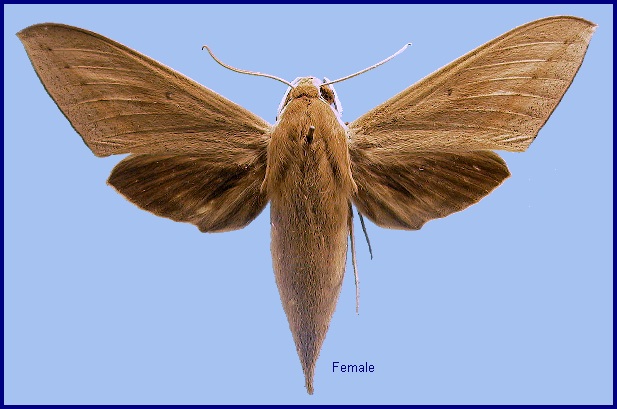
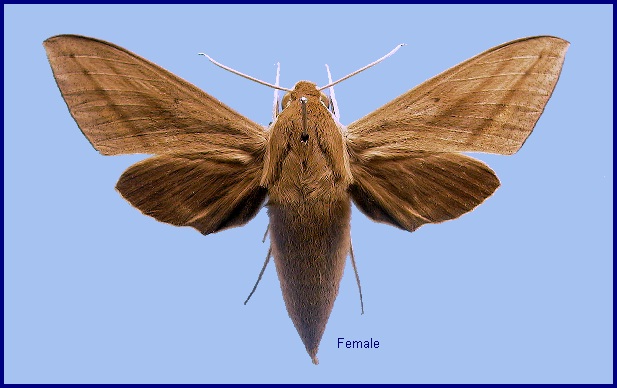
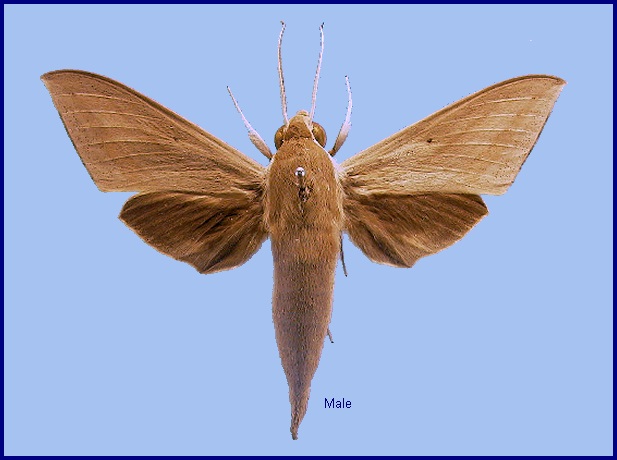
Chaerocampa [sic] lucasii Walker, 1856, List Specimens lepid. Insects Colln Br. Mus. 8: 141. Type locality: North India; [Bangladesh,] Silhet [Sylhet].
Synonym. Chaerocampa lucasii Walker, 1856.
Synonym. Deilephila spilota Moore, 1858.
Synonym. Chaerocampa procne Clemens, 1859.
Synonym. Chaerocampa tenebrosa Moore, 1877.
Synonym. Theretra latreillii distincta Clark, 1922.
Synonym. Theretra latreillii montana Clark, 1922.
Synonym. Theretra latreillii lucasii Walker, 1856.
Note. Synonymized with Chaerocampa latreillii by Miskin, 1891, Proc. Roy. Soc. Qd 8: 17. Reinstated as a species by Semper, G., 1896, in Semper, C., Reise Archipel Philipp. 2: 398. Resynonymized with Theretra latreillei [sic] as a subspecies by Rothschild & Jordan, 1903, Novit. zool. 9 (suppl.): 773, who nevertheless stated (p. 772) that the two subspecies of latreillii intergrade completely. Reinstated as a species by Moulds, Tuttle & Lane, 2020, Hawkmoths of Australia 3: 250.
Wingspan: 64--86mm. Head and body drab, antenna, front of head and sides of thorax paler; abdomen with no black side patches and no stripes. Forewing drab with six discal lines, the first nearly always dilated near apex of cell; a black basal patch at inner margin more or less vestigial; a black speck at end of cell. Hindwing smoky-black, paler towards anal angle. Underside buff or vinaceous-buff. Cavity at end of first segment of palpus partly concealed by irregular scaling. External row of spines of first protarsal segment double, at least at base.
Resembling a small Theretra rhesus but forewings conspicuously less elongate and hindwings more rounded apically. Very similar to Theretra latreillii but forebasitarsus with outer row of spines single and dorsal lines of abdomen more or less plainly marked. Forewing upperside similar to Theretra latreillii but postmedian and submarginal oblique lines clearly visible.
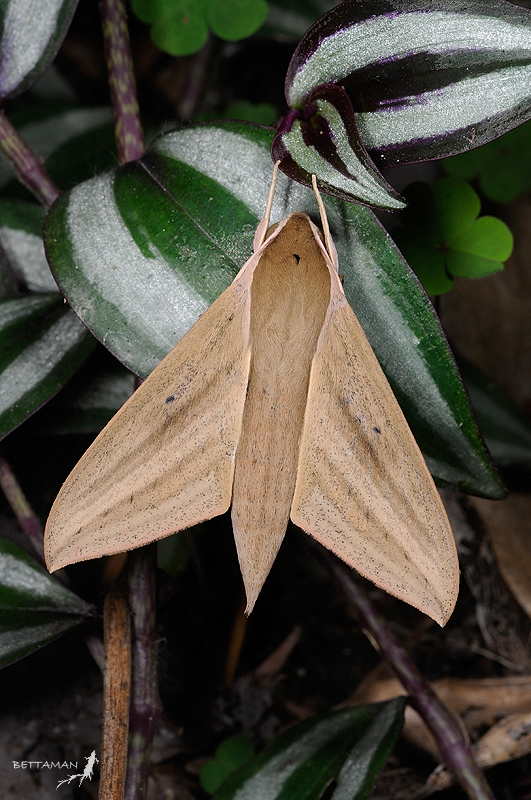
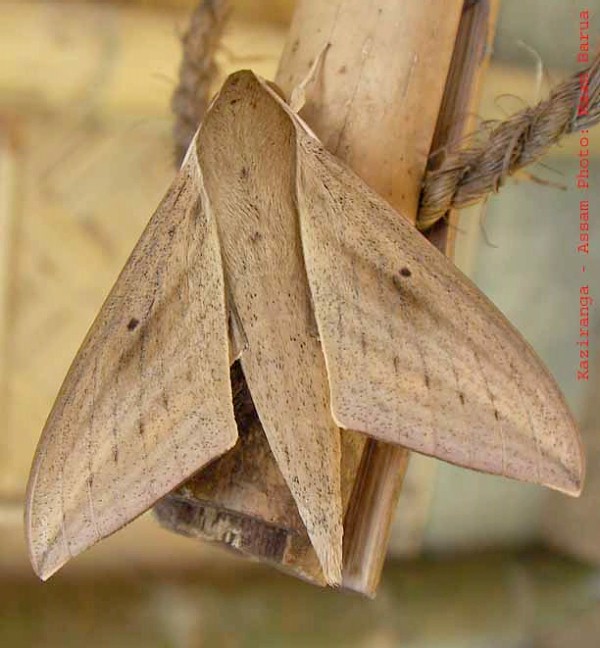
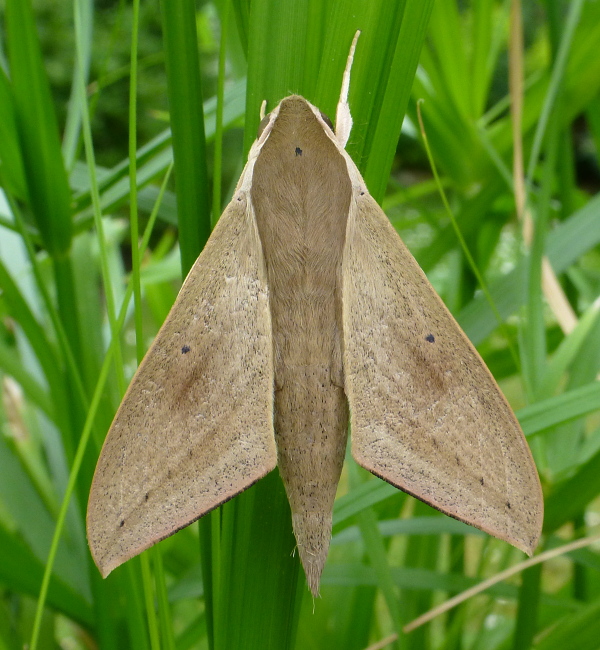
The moth starts feeding before dark and frequently comes to light (Bell & Scott, 1937).
In Metro-Manila, the Philippines, this synanthropic species has been reported as being active at daybreak and during rainy weather, when it has been observed to drink from water puddles next to roads (Dvořák, 2014).
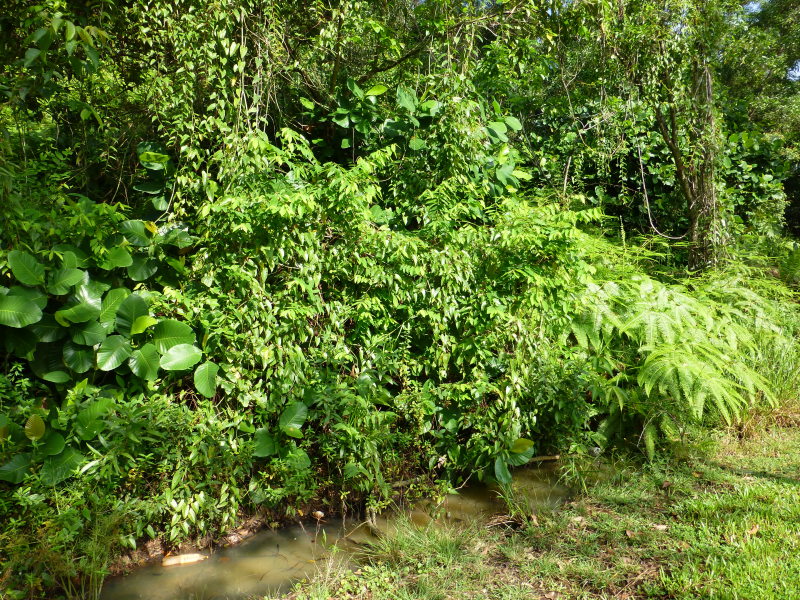
China: iii (Guangxi); iv-vii (Hong Kong); v (Guangdong); vii (Guangdong); viii (Hainan; Guangxi); ix-x (Hong Kong); xi (Guangdong). Taiwan: v-x (Hualien Hsien); vii (Tainan); viii (Nantou Hsien); ix (Kaohsiung).
Kendrick (2002) states that this species is multivoltine in Hong Kong, occurring from April until late July, and from mid September until mid October.
OVUM: Bright grass-green, slightly oval (1.3 x 1.5mm), shiny and smooth (Bell & Scott, 1937).
LARVA: Full-fed 60mm, width 11 mm.; horn 5 mm. According to Bell & Scott (1937), in the first instar head yellow, body greenish-yellow; horn very long, straight, shiny black in colour. In the second instar, head yellowish-green, body shiny green. There is a small dull purplish dorso-lateral eye-spot on segment 5, and a whitish dorso-lateral stripe from 5 to base of horn. Latter black with red base. In the third instar, green dotted with yellow; dorso-lateral stripe yellow. By the fourth instar, dorsum with white dots; the eye-spot with pupil black in front, red behind, the red portion containing a yellow inverted comma-shaped marking, the whole edged narrowly with blue and then black. The dorso-lateral stripe edged above with purple on segments 11 and 12. Horn pale greenish-brown dorsally, still paler ventrally, with small black tubercles.
In the fifth and final instar, head with dorsal line slightly depressed on vertex; clypeus one-half length of head, apex acute, basal angles rounded; apex of false clypeus forming a wide gothic arch over apex of true clypeus, reaching to two-thirds length of head; labrum nearly half as long as clypeus, tapering frontad, longitudinally ridged; ligula as long as labrum; cutting-edge of mandible obscurely toothed. Surface of head dull, under a lens seen to be transversely wrinkled. Body as in others of the genus, dull and smooth, segments 5 and 6 not much swollen. Horn of medium length, stout at base, tapering gently till near the tip, where it suddenly narrows to a point. Basal half of horn straight and rising vertically, distal half bent sharply downwards; surface dull and covered with small tubercles.
In the green form, head green, labrum, ligula and basal segment of antenna green, other segments of antenna soiled white; mandible green with tip narrowly brown; eyes brown. Body grass-green with encircling rows of coalescing dots around each secondary ring on segments 5 to 12, whitish above the dorso-lateral stripe, yellow below it. There is a narrow black dorsal stripe on 2 to 5; a dorso-lateral eye-spot on 5 coloured as in the fourth instar, but when nearly full-fed the yellow comma-shaped mark disappearing. There is a yellow suffusion between the eye-spot over the dorsum; a narrow white dorso-lateral stripe from 6 to base of horn. Horn green; legs red. Spiracles elongate-oval, fuscous, the ends shortly yellow, the whole edged narrowly with black and then yellow.
In the dark-coloured form the head is dark brown dotted with paler brown; labrum and ligula brown; basal segment of antenna whitish, other segments reddish; mandible yellow, tip shortly brown. Body dark chocolate-brown, the transverse dots paler brown with black dots between them; the ocellus as in the green form; the dorso-lateral stripe formed of pink dots on segments 4 and 5, missing on 6 to 10, pink on 11 and 12. Horn dusky black, the tip shortly yellowish; legs yellow with a black patch on each segment and a black line down the outer side; venter of 2 to 4 pale brown edged broadly with dark brown.
Further details of the complete life cycle in Thailand are given by Kilaso & Tigvattananont (2018).
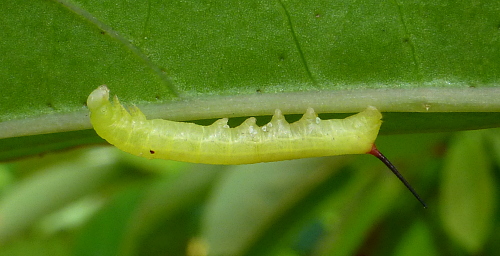
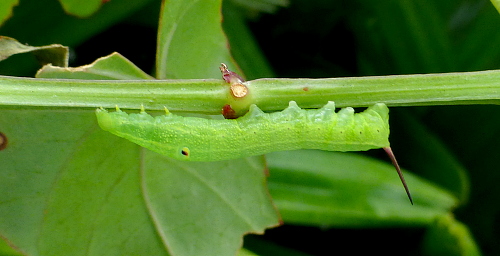
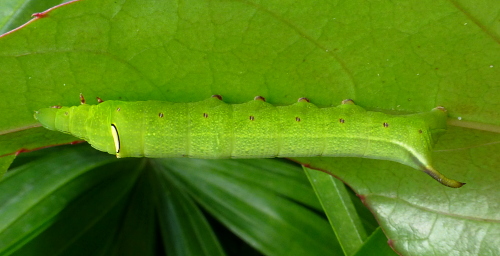
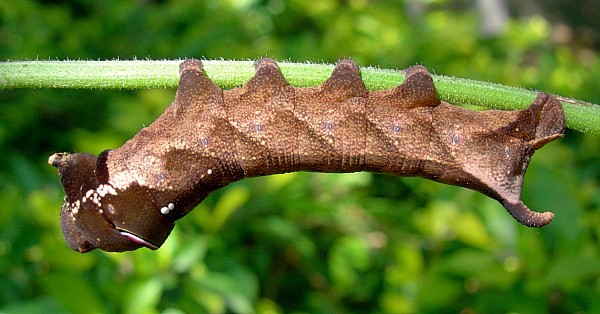
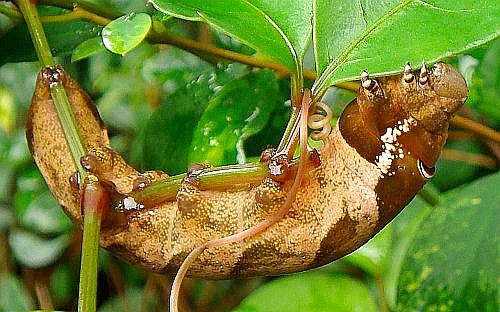
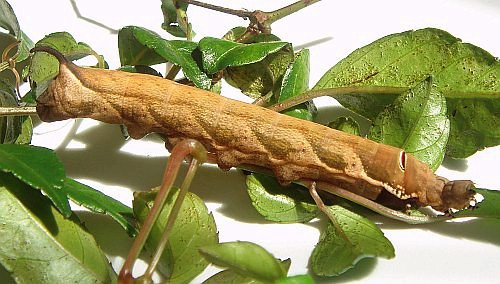
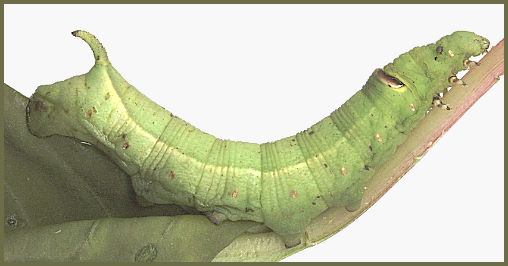
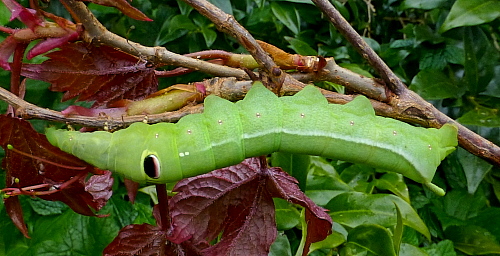
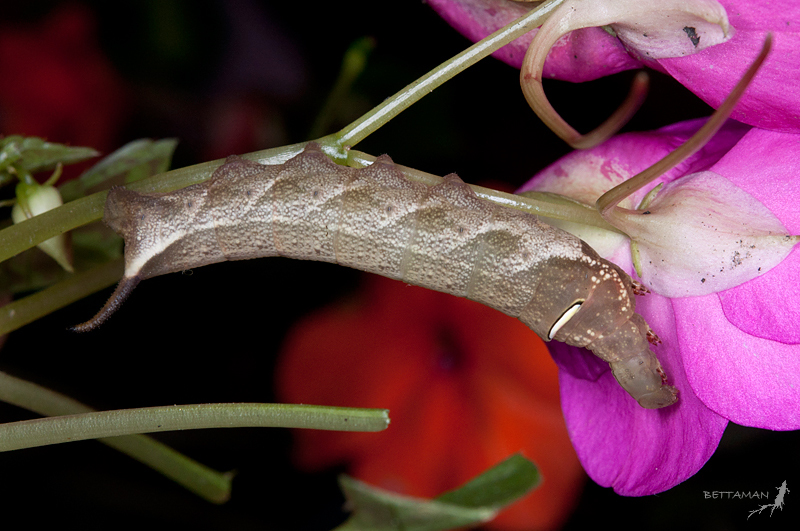
PUPA: 50mm, width 11mm, tongue-case projecting 2 mm. in front of head. Of a pinkish bone-colour, wing-case paler, head and thorax suffused with greenish and speckled profusely with brown except on a broad dorsal stripe, which is only lightly speckled. There is a broad dark brown dorsal stripe from segment 4 to 12; abdomen with a broad brown spiracular and a narrow brown ventral stripe, the sides and venter speckled with brown, the segment of a circle behind spiracle of 2 black, other spiracles bone-colour, the central slit with a dark reddish-brown rim; cremaster brown.
The tongue-case not very prominent, semicircular in side-view. Antenna slightly longer than proleg, which reaches to about one-third the distance to tip of wing-case, mid-leg to two-thirds; a narrow coxal piece is present. Surface dull, head, thorax and wing-case slightly shiny; head and thorax very shallowly, irregularly corrugate. Abdomen finely transversely wrinkled; front bevel of segment 9 transversely lined. Spiracle of 2 a narrow slit lying between the hind margin of 2 and the straight, slightly raised front margin of 3; from the raised front margin of 3 a small area shaped like a segment of a circle projects posteriad, its surface depressed posteriad; remaining spiracles elongate-oval, the central slit lying in a narrower, raised oval. Cremaster triangular, flattened, tip, broadly truncate, ending in two short, widely separated teeth; segment 14 shallowly axially hollowed under base of cremaster.
The pupa is not attached to the inside of the cocoon.





Larval hostplants. Saurauia tristyla (Actinidiaceae), Melia azedarach (Meliaceae), Ampelopsis brevipedunculata and Ampelopsis cantoniensis (Vitaceae) in Hong Kong (Tennent, 1992), as well as Impatiens (David L. Mohn, pers. comm. 2002). Also Impatiens, Lagerstroemia, Vitis and Begonia in India (Bell & Scott, 1937).
On Taiwan recorded from Ampelopsis brevipedunculata, Ampelopsis cantoniensis, Begonia semperflorens, Causonis japonica [syn. Cayratia japonica], Cissus verticillata [syn. Cissus sicyoides], Impatiens balsamina, Impatiens walleriana, Leea guineensis, Ludwigia octovalvis, Ludwigia peploides, Psychotria serpens and Tetrastigma formosanum.
In Metro-Manila, the Philippines, larvae have been found on various species of Cayratia (Dvořák, 2014), and in Thailand on Ludwigia hyssopifolia (Küppers & Janikorn, 2019).
China: Zhejiang (Ningbo); Yunnan (Gaoligong Shan); Fujian (Fuzhou; Longqi Shan); Guangdong (Dinghushan; ??Wa-Sha-Tai; Guangzhou); Macau; Hong Kong (Kowloon); Guangxi (Bamian, Jiajiu Shan; Liuzhou); Hainan (Chengmai; Weining).
Taiwan: Hualien Hsien (Taroko National Park; Antung; Hungyeh); Tainan; Chiayi Hsien (Quantzelin/Kuantzulin); Nantou Hsien (Puli); Taipei (Jingmei); Taoyuan Hsien; Miaoli Hsien; Taichung Hsien; Kaohsiung Hsien; Pintung Hsien; Taitung Hsien (Chihpen); Taipei Hsien.
From southeast Pakistan (Rafi et al., 2014), the Western Ghats (India) and Sri Lanka. Then Nepal and northeastern India, east to southern China and Taiwan, and southeast though Indochina as far east as the Philippines, Sulawesi and the eastern Lesser Sunda Islands. Also Great Nicobar Island (Singh, Ahmad & Chandra, 2021).
[Replaced in the Maluku Islands by Theretra latreillii prattorum Clark, 1924; and in New Guinea, Australia, the Bismarck Archipelago and the Solomon Islands by Theretra latreillii latreillii (Macleay, 1826).]
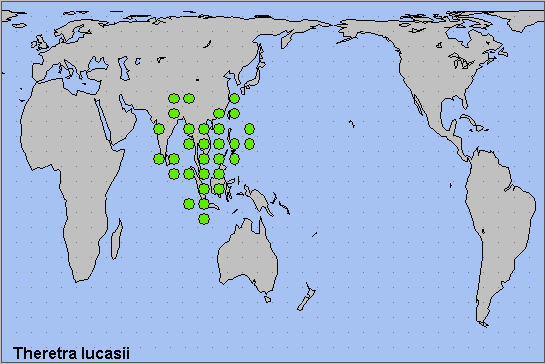
 Return to Sphingidae of the Eastern Palaearctic species list
Return to Sphingidae of the Eastern Palaearctic species list